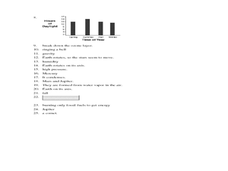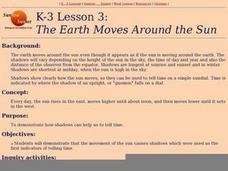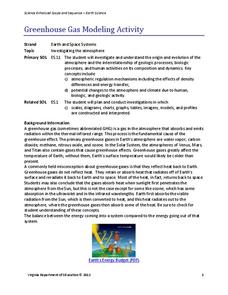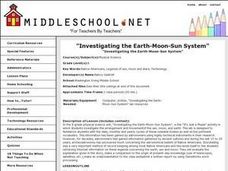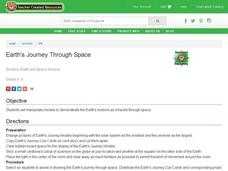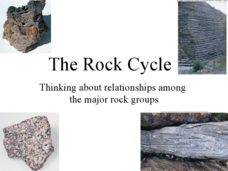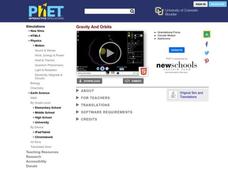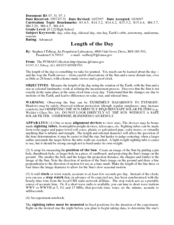Curated OER
Fourth Grade Science Concepts Practice
In this grade 4 science worksheet, 4th graders complete 25 multiple choice questions covering a variety of 4th grade science concepts. An answer key is included.
Curated OER
The Earth Moves Around the Sun
Students demonstrate that the movement of the sun causes shadows which were used as the first indicators of telling time.
Curated OER
Earth's Poles
In this Earth's Poles worksheet, learners survey, examine and dissect the North and South Magnetic Poles, the Earth's axis and summarize the Aurora legends. Students research six directives involving space weather and predicting answers.
Columbus City Schools
Moon Phase Mania
Now you see it, now you don't. Our moon seems to pull a disappearing act from time to time—but why? Take your seventh grade scientists above and beyond to discover the truth about the moon and the role it plays in Earth's little...
Purdue University
Global Design for the Seasons
People don't all get the same amount of sun at the same time of the year. Collaborative groups explore how the motion of Earth contributes to the idea in an inquiry-based STEM lesson. Learners first investigate how the rotation of Earth...
Curated OER
A Model Solar System
If Earth is modeled by a grapefruit, what planet could be represented by a golf ball? This activity uses everyday and not-so-everyday objects to create a model of the Solar System.
Virginia Department of Education
Greenhouse Gas Modeling Activity
Why are greenhouse gases called greenhouse gases? Young Earth scientists learn about greenhouse gases though experimentation in the second installment of a 3-part series. They use lamps to model radiant energy as well...
Curated OER
Solar Sweet Tea
Students study the sun. In this heat energy lesson, students use the sun's warmth to make tea. They place a few jars with tea bags and water in the sun and discuss what the sun is doing to the water while they wait for the tea to brew....
School Science
The Big Bang Time Machine
Scholars take off on an interactive spaceship to explore a historical timeline of the big bang theory. They learn about the evolution of mammals and humans, the formation of stars and planets, and the chemical composition of the early...
K20 LEARN
This Is How the World Ends: Coronal Mass Ejections/Space Storms
Is this the end of the world as we know it? Pupils prepare for a coronal mass ejection during a lesson from the K20 Center. The activity combines video and Internet research in a collaborative assignment that focuses on public safety...
Curated OER
Effects of the Sun on Our Planet (Grades 2-4)
Students observe how the sun's rays can cause evaporation and discuss its role in the weather cycle. They discover what the sun's energy brings to plants. They examine how different types of technology can enhance the amount of solar...
Curated OER
Investigating the Earth-Moon-Sun System
Eighth graders research Native American legends involving the sun, moon, and stars and compare them to the origin of present day knowledge. They create a written report and make an oral presentation of their findings to the class.
Curated OER
How Big is the Sun? Exploring the Size and Scale of the Sun, Earth and Moon
Students explore the relative sizes of the Sun, Earth and Moon as they make an impressive large-scale model for classroom use throughout the unit.
Curated OER
The Sun: An Introduction
Students write entries in their Science Journals as they explore the Sun.
Curated OER
Earth, Sun, and Moon
In this earth, sun, and moon practice worksheet, students examine 6 pictures and follow the instructions to shade in the part of the Earth that is in darkness.
Curated OER
Earth's Journey Through Space
Learners arrange various pictures of the Earth to identify its journey through space. In this Earth's rotation instructional activity, students use models of the Earth and demonstrate its journey through space. Learners complete the...
Curated OER
The Rock Cycle - Thinking About Relationships Among the Major Rock Groups
Step-by-step, arrow-by-arrow, viewers are walked through the rock cycle. In the end, you have a simple, yet complete diagram of the process. Pictures appear to show samples of igneous, sedimentary, and metamorphic rocks. The presentation...
Curated OER
Ocean Waves and Tides
Except for a few blurry photos that you can leave out, this is a succinct, yet purposeful presentation. It explains what causes ocean waves, the parts of a wave, and how they break against a shore. It details the cause of tides and...
PHET
Gravity And Orbits
Have you ever wanted to turn off gravity? This simulation allows learners to do just that in addition to altering other variables. Scholars can move the sun, Earth, moon, and space station to see how distance affects gravitational pull....
Curated OER
Chalkboard Challenge: Science Vocabulary
Students play a Jeopary-style game in this engaging PowerPoint. The scientific categories are the solar system, planet, weather, cells, and rocks. These types of interactive games are an excellent way to reinforce the important...
Curated OER
Length of the Day
High schoolers investigate how the Earth's rotation affect the length of day. In this earth science lesson, students construct a sighting apparatus and record their observations over a few days. They analyze data collected and formulate...
Curated OER
Water Cycle
Students identify the different stages in the water cycle. In this earth science lesson, students calculate the residence time of water in oceans using a mathematical formula. They explain how this cycle regulates the Earth's climate.
Curated OER
Sky Time: On the Astronomical Meaning of the Day, Year and Seasons
Students simulate the movement of the Earth using their body motion. In this earth science lesson, students explain how this causes seasonal changes on Earth.
Curated OER
Volcanic IntEruptions
Seventh graders research about a devastating eruption of a certain volcano. In this earth science lesson, 7th graders discover the climate changes that occurred due to a volcanic eruption. They create a presentation about their findings...


